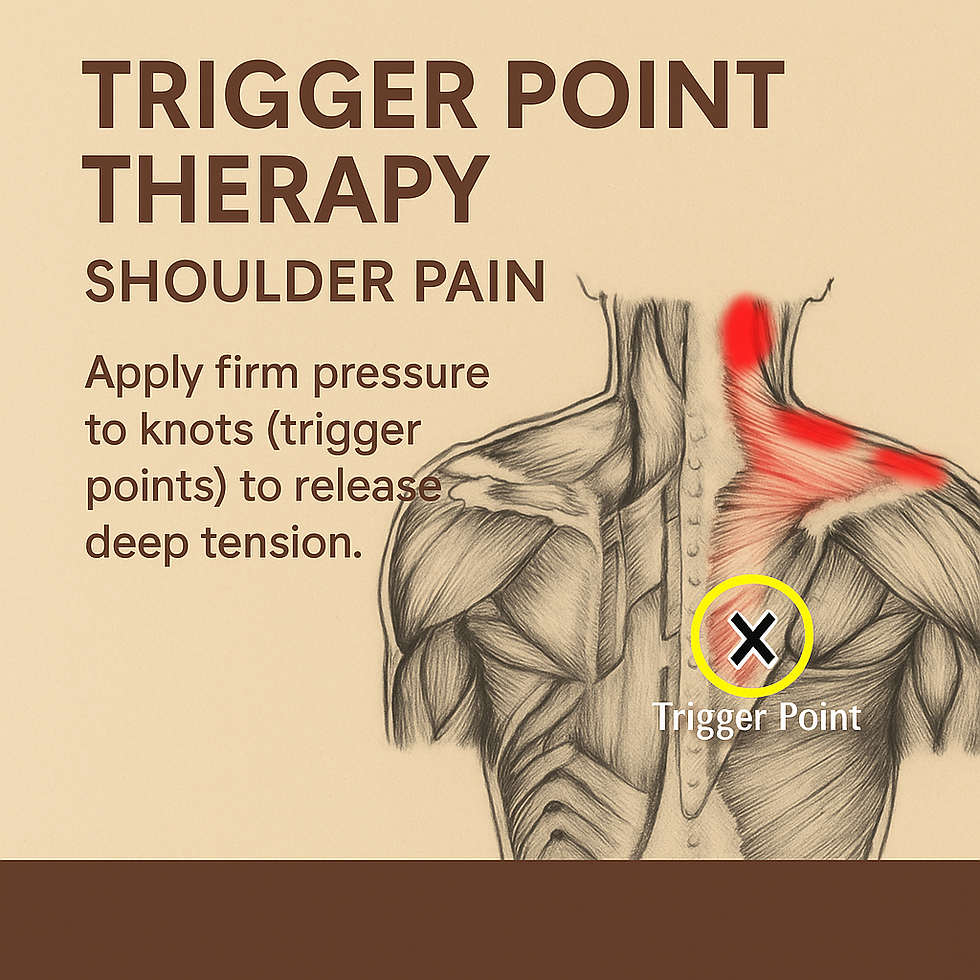Understanding Trigger Points: Why They Cause Shoulder Pain and How Massage Helps
- Serene Healing
- Aug 27
- 2 min read
Have you ever felt a tight “knot” in your shoulder that seems to ache, limit movement, or even cause pain somewhere else in your body? That’s what massage therapists call a trigger point — and they’re one of the most common causes of muscle discomfort.
🔬 What is a Trigger Point?
A trigger point is a sensitive, hyperirritable spot in a muscle. Scientifically, it’s thought to form when part of the muscle fibers become over-contracted, restricting blood flow and oxygen supply to that small area. This creates a painful nodule or “knot” that can be felt under the skin.
Because the muscle isn’t getting enough oxygen and nutrients, waste products also build up, irritating local nerve endings. This is what makes the area tender to the touch and why pressing on it can sometimes send pain to other regions — known as referred pain.
💡 Why Do Trigger Points Develop?
Trigger points can form for several reasons, including:
Poor posture (like hunching over a desk)
Muscle overuse (sports, repetitive work)
Stress and tension
Injury or strain
Lack of movement or prolonged sitting
🌀 Referred Pain Explained
One unique feature of trigger points is that they don’t just cause pain at the site. They can “refer” pain to other areas of the body. For example, a trigger point in your upper shoulder may cause headaches, neck tension, or pain down the arm.
This is why shoulder knots often feel like they’re radiating discomfort rather than staying in one place.
💆 How Massage Therapy Helps
Massage therapists use Trigger Point Therapy to apply sustained, firm pressure to the knot. Th
is does three important things:
Increases blood flow to bring oxygen and nutrients back to the muscle.
Flushes out waste products that have built up.
Resets muscle fibers, allowing them to relax and function normally again.
The result? Reduced tension, less referred pain, and improved mobility.
✅ Takeaway
Trigger points are more than just “knots” — they’re small but powerful sources of muscle pain and dysfunction. Understanding how they work helps explain why targeted massage therapy can bring such big relief, especially for stubborn shoulder pain.
So, if your shoulders feel tight, achy, or radiating discomfort, Trigger Point Therapy could be the key to unlocking lasting relief.
📚 References
Travell, J. G., & Simons, D. G. (1999). Myofascial Pain and Dysfunction: The Trigger Point Manual (Vols. 1–2). Lippincott Williams & Wilkins.
Simons, D. G. (2002). Review of enigmatic MTrPs as a common cause of enigmatic musculoskeletal pain and dysfunction. Journal of Electromyography and Kinesiology, 12(1), 95–107.
Fernández-de-Las-Peñas, C., & Dommerholt, J. (2018). Trigger Point Dry Needling: An Evidence and Clinical-Based Approach. Elsevier.
Gerwin, R. D. (2014). Diagnosis of myofascial pain syndrome. Physical Medicine and Rehabilitation Clinics, 25(2), 341–355.






Comments